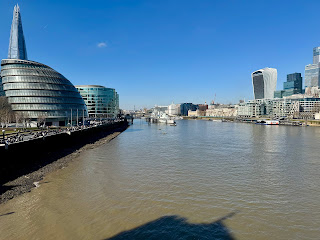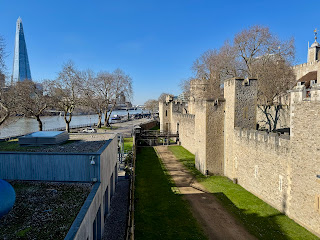Before we leave London (pop 8.67 million in 2022), we have one more day to get to know our new (temporary) home in Bermondsey. It's a beautiful sunny morning, and we head for the Tower Bridge (Horace Jones, late 19th century). This is a comfortable, mixed area of new mid-rises and older brick storefronts.
We cross underneath the railroad tracks; The Shard (Renzo Piano, 2013), ever-present, appears above the arches. We reach the entry arch of Tower Bridge; exaggerated gargoyles flank the steel anchor members.
From the main deck, there are amazing views southwest to London City Hall (Norman Foster, 2002) and the skyline along the River Thames. Bascule-type operable spans are between the two main towers, which are additionally connected above by a pair of trussed walkways. On either side are the suspension bridge spans, with the shorter towers and abutments on either end.
The catenaries are two sets of inverted, asymmetrical arched trusses, bright in baby-blue, and joined by large, crimson 'rosette' steel plates. The railings are a darker blue, and the suspension cables are in white – a very British scheme.
On the north bank are 'The Walkie-Talkie' (Rafael Viñoly, 2009-14) and 'The Gherkin' (Norman Foster, 2001-04), facing The Shard and City Hall.
The neo-Gothic Bridge provides a theatrical introduction to London Tower (11th-13th centuries), an authentically imposing defensive complex, with its wide moat, curtain wall, battlements, and bastions.
We make our way around the edge of the moat. The sandy stones raked by the sunlight and set off by the green lawn. White downspouts create a rhythm. The distinctive shapes of the skyscrapers break the horizon above the irregular towers – astonishing how the two eras blend.
At the far north end, Tower Hill Plaza, and the Tower Place Mall offers coffee shops and restaurants; a convenient place to stop for lunch.
From the plaza on the north side, we ascend to the street level. Here, the Old London Port Authority (Edwin Cooper, 1922; now the Four Seasons Hotel) stands over the Tower Hill Memorial (Edwin Lutyens, 1928).
Walking towards the rivers, we step down to the Tower Vaults. The flowing shapes of the copper spire atop All Hallows-by-the-Tower (11th to 15th centuries, rebuilt 17th century) contrast the plastic lines of 'The Walkie Talkie'.
We continue our walk along the riverside to London Bridge (20th century), past the Old Customs House (David Laing, 18th century) and Old Billingsgate (John Jay, 19th century) – which, in past days, had obviously been a fish market.
We happen to catch the sun just behind The Shard, which does its best Tolkien impression.
From London Bridge, we have a view back to the Tower Bridge, with the HMS Belfast (top image) floating in the Thames.
We close the loop and return to Bermondsey. Near the London Bridge train station there is a market area called Flea London, and a street art sculpture called Blue Moon (Joe Rush, 2019). Right next door, new tall buildings rise; even inside the covered stalls, the skyline peeks through.
The renovated warehouses contain posh art galleries and small museums, and the new glass reflects the setting light on the old bricks.











































No comments:
Post a Comment